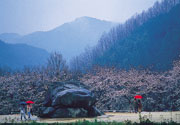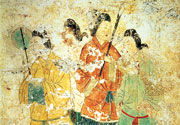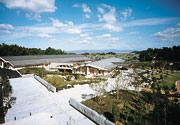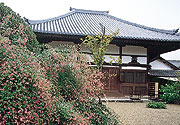 |
 |
| An ancient tomb
built from gigantic stones |
|
 |
 Ishibutai,
made from 30 gigantic stones, is one of the largest stone
tombs in Japan and is a symbol of the Asuka Area. Its stone
chamber is 19.1m long and the burial chamber is 7.7m high,
3.9m wide and 7.6m deep. The total weight of the stones is
said to be 2,300t. The gigantic stone on top of the tomb weighs
77t, and is the largest of its kind among ancient Japanese
tomb. Ishibutai,
made from 30 gigantic stones, is one of the largest stone
tombs in Japan and is a symbol of the Asuka Area. Its stone
chamber is 19.1m long and the burial chamber is 7.7m high,
3.9m wide and 7.6m deep. The total weight of the stones is
said to be 2,300t. The gigantic stone on top of the tomb weighs
77t, and is the largest of its kind among ancient Japanese
tomb.
 0744-54-3240
(Asukamura Village Sightseeing Development Public Corporation)
/8:30 - 17:00 / Open 7 days a week 0744-54-3240
(Asukamura Village Sightseeing Development Public Corporation)
/8:30 - 17:00 / Open 7 days a week
  250 250
 Take
bus No.2 or 5 from Kintetsu Kashihara Jingu Mae Station and
get off at Ishibutai. Take
bus No.2 or 5 from Kintetsu Kashihara Jingu Mae Station and
get off at Ishibutai. |
 |
 |
 |

Takamatsuzuka Burial Mound and Wall Painting
Museum |
 |
| Tomb wall paintings
preserved in full color using modern technology |
|
 |
 This
is a small circular tomb approx.18m in diameter and 5m high.
Modern technology is used to keep the temperature and humidity
inside the tomb as stable as possible in order to preserve
the wall paintings. Visitors are not allowed to enter the
tomb. The Wall Painting Museum adjacent to the Mound displays
full color replicas of paintings of human figures, the constellations,
a blue dragon and a white tiger and contains various other
burial artifacts. The facility gives full explanations of
the Takamatsuzuka Burial Mound in a plain and straightforward
manner. This
is a small circular tomb approx.18m in diameter and 5m high.
Modern technology is used to keep the temperature and humidity
inside the tomb as stable as possible in order to preserve
the wall paintings. Visitors are not allowed to enter the
tomb. The Wall Painting Museum adjacent to the Mound displays
full color replicas of paintings of human figures, the constellations,
a blue dragon and a white tiger and contains various other
burial artifacts. The facility gives full explanations of
the Takamatsuzuka Burial Mound in a plain and straightforward
manner.
 0744-54-3340
/ 9:00 - 17:00 / Open 7 days a week 0744-54-3340
/ 9:00 - 17:00 / Open 7 days a week
  250 250
 A
10-minute walk from Kintetsu Asuka Station A
10-minute walk from Kintetsu Asuka Station |
 |
 |
 |

Nara Prefectural Complex of Man'yo Culture |
 |
| Feel the breath
of Man'yo Culture |
|
 |
 Designed
around the theme of the Man'yoshu, the poetry anthology in
the 8th century and other aspects of ancient culture, the
Nara Prefectural Complex of Man'yo Culture is a pleasant place
to learn about the ancient period. The facility includes a
display of Japanese paintings with the Man'yoshu as a theme,
and includes displays of the oldest coins in Japan, excavated
during the construction of the Complex. Other items include,
reproduction of an ancient market square, a theater showing
poets of the Man'yo poetic anthology, an information search
system called "Man'yo Hyakka System," and a library containing
10,000 books. It's an information station dedicated to the
Man'yo culture. Designed
around the theme of the Man'yoshu, the poetry anthology in
the 8th century and other aspects of ancient culture, the
Nara Prefectural Complex of Man'yo Culture is a pleasant place
to learn about the ancient period. The facility includes a
display of Japanese paintings with the Man'yoshu as a theme,
and includes displays of the oldest coins in Japan, excavated
during the construction of the Complex. Other items include,
reproduction of an ancient market square, a theater showing
poets of the Man'yo poetic anthology, an information search
system called "Man'yo Hyakka System," and a library containing
10,000 books. It's an information station dedicated to the
Man'yo culture.
 0744-54-1850/10:00-17:30
/ Closed on Wednesdays (or the following Thursday if the Wednesday
falls on a national holiday) 0744-54-1850/10:00-17:30
/ Closed on Wednesdays (or the following Thursday if the Wednesday
falls on a national holiday)
  600 600
 Take
bus No.2 from the east exit of Kintetsu Kashihara Jingu Mae
Station and get off at Man'yo Bunkakan Nishiguchi. Take
bus No.2 from the east exit of Kintetsu Kashihara Jingu Mae
Station and get off at Man'yo Bunkakan Nishiguchi. |
 |
| Asuka Daibutsu,
the earliest Great Buddha statue extant in Japan |
|
 |
 Established
in 596 A.D. by Soga-no-Umako who was an enthusiastic supporter
of Buddhism, Asukadera Temple was originally three times as
large as Horyuji Temple, according to old reports. Such a
gigantic temple reminds us of the powerful Soga Clan of the
times. "Yakushi Nyorai", otherwise known as Asuka Daibutsu,
a divine savior said to relieve people's present agony, is
the earliest large-sized Buddha statue in Japan, and is designated
as an important cultural asset. Established
in 596 A.D. by Soga-no-Umako who was an enthusiastic supporter
of Buddhism, Asukadera Temple was originally three times as
large as Horyuji Temple, according to old reports. Such a
gigantic temple reminds us of the powerful Soga Clan of the
times. "Yakushi Nyorai", otherwise known as Asuka Daibutsu,
a divine savior said to relieve people's present agony, is
the earliest large-sized Buddha statue in Japan, and is designated
as an important cultural asset.
 0744-54-2126
/ 9:00 - 17:15 (or 9:00 - 16:45 from October to March ) /
Open 7 days a week 0744-54-2126
/ 9:00 - 17:15 (or 9:00 - 16:45 from October to March ) /
Open 7 days a week
  300 300
 Take
bus No.2 from Kintetsu Kashihara Jingu Mae Station and get
off at Asuka Daibutsu Mae. Take
bus No.2 from Kintetsu Kashihara Jingu Mae Station and get
off at Asuka Daibutsu Mae. |
|

